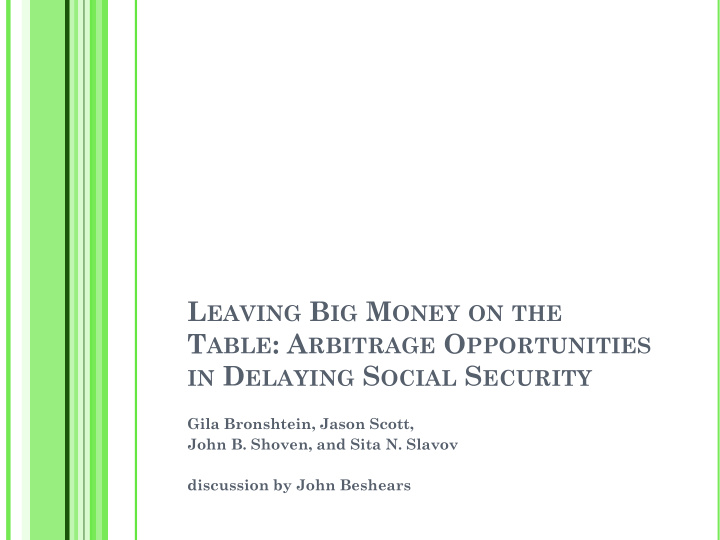



L EAVING B IG M ONEY ON THE T ABLE : A RBITRAGE O PPORTUNITIES IN D ELAYING S OCIAL S ECURITY Gila Bronshtein, Jason Scott, John B. Shoven, and Sita N. Slavov discussion by John Beshears
S UMMARY About one-quarter of people claim Social Security early and simultaneously receive pension or annuity income Alternative: Defer Social Security and take a lump-sum pension payout (or do not purchase annuity) After-tax income the same during deferral period but higher by ~5% of primary benefit afterwards (for couples) Plus inflation protection Higher when the proceeds come from not buying an annuity This discussion Relationship to previous literature Why? What should be done?
T ABLE 3 – M ARRIED M EN B ORN A FTER 1940
R ELATIONSHIP TO P REVIOUS L ITERATURE Leaving 401(k) employer match on the table (Choi, Laibson, and Madrian 2011) – loss is $500 per year for ~5 years Prepaying mortgage instead of contributing to 401(k) (Amromin, Huang, and Sialm 2007) – loss is $400 per year for ~10 years Carrying credit card debt instead of taking out a 401(k) loan (Li and Smith 2010) – loss is $300 per year for ~20 years This paper – loss is easily $10,000 or more
W HY A RE P EOPLE M AKING A M ISTAKE ? People treat the Social Security claiming decision separately from the pension lump sum or annuity purchase decision Within each of the separate decision-making problems, people try to reach a reasonable outcome Social Security claiming Psychological link to retirement decision Framing of “normal retirement age” Tendency to choose the “middle option” Avoiding loss of never receiving benefits Pension lump sum decision For defined benefit plans, the default is an annuity stream Employer communication around retirement income Lump sum option may not be available
W HAT S HOULD B E D ONE ? Employers Offer partial lump-sum cash-outs in defined benefit plans AND, in both defined benefit and defined contribution plans, offer advice or a product that integrates the Social Security claiming decision into the annuitization decision “Social Security Leveling” – program provides high payments before age 70, lower payments starting at age 70, and constant income for the rest of life when combined with Social Security Government Maybe nothing should be done If we eliminate this mistake, we have effected a transfer This is not free and in fact shifts resources to those who are already doing well
Recommend
More recommend